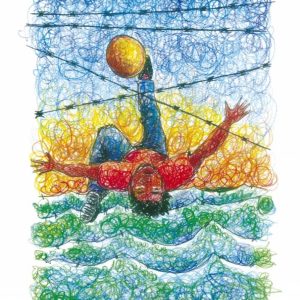
Story:
At first glance we see only the boy with the ball. He could be the kid down the block. We smile at his exuberance. We marvel at his skill. We worry for his safety, since he seems more intent on scoring a goal than on landing well.
But then we look more closely. The “net” is made of barbed wire. And why is he suspended over the waves? Look more closely still. The waves, the sky, and even the sunset are filled with barbed wire. What kind of a game is this?
It is not a game at all. This is a heroic attempt to break free from oppression, poverty, and war. This is a beautiful child who is willing to risk everything for a new life. The barbed wire is the border that binds his future and scars his soul.
Maybe that’s why Francesco Piobbichi calls this drawing, “Kick the Fear.” Here is what he says about his drawings in general:
My drawings are conceived and end in a matter of minutes [using] vivid colors that give hope mixed with the pain they recount. The colors, scrawled onto the page, swirl as in the vortex of a storm; they almost tear the paper on which they are drawn. My drawings reveal the hatred that surrounds the migrants and the barbed wire that sticks in their skin, barriers so oppressive that the migrants will always live with it wherever they go. My drawings are an act of love for humanity—I would consider them emblems of justice and freedom (Drawings from the Border, p. vi).
Bible Reading: Isaiah 61:1 (NRSV)
The “Suffering Servant” of Isaiah’s prophecy announces good news to the people imprisoned in Babylon:
The spirit of the Lord God is upon me, because the Lord has anointed me; he has sent me to bring good news to the oppressed, to bind up the brokenhearted, to proclaim liberty to the captives, and release to the prisoners.
The messenger may have been new, but the message was not. This was the theme-song of the exodus, after all. And if we trace the trajectory into the New Testament, we can hear the Suffering Servant singing the same song there. Our God is a god who liberates captives and binds up the broken-hearted. Second verse, same as the first.
Once we learn the melody of God’s theme-song we begin to recognize it in all sorts of places. One of the places I hear it is in these stories from the border. It makes me want to join God in that liberating song.
Discussion/Reflection:
- Where do you hear God’s liberating song? How might you join in?
- Had you noticed the barbed wire in Piobbichi’s drawings? What does that image evoke for you? How might we be contributing to it?
Action:
- Look for the “barbed wire” in your community and find some ways to start cutting it down.
- Learn more about what Protestant Christians are doing to join God’s liberating song: An Appeal to Christians and Faith-Based Organizations
Prayer: We, created in your image, would a true reflection be of your justice, grace, and mercy and the truth that makes us free.
Welcoming the Stranger Series
In the last ten years more than 35,000 asylum seekers have died in the Mediterranean. Desperate to escape untenable situations in countries like, Syria, Eritrea, Sudan, and Somalia, refugees risk both life and livelihood to board rickety boats bound for what they hope will be a new life in Europe. Many of them die within sight of what they hoped would be the promised land.
Welcoming the Stranger is a devotional series designed to help Christians connect this unfolding humanitarian crisis in the Mediterranean with the Bible’s call to “welcome the stranger.” Recognizing that “the stranger” can sometimes be an abstraction that blinds us to the face of Christ, the series approaches the refugee crisis from a personal perspective. Each entry focuses on one person’s story, brought vividly to life by Italian artist and relief worker, Francesco Piobbichi. These stories are then linked to relevant Scripture, prayer, discussion, and action prompts.
Immigration is a hot topic around the globe, and the Bible passages in this series speak to wherever we are called to “welcome the stranger.” My specific interest in the Mediterranean context was sparked by a 2016 trip to the island of Lampedusa—a small island off the coast of Sicily that is the scene of so much hope and tragedy for refugees trying to enter Europe via small, unsafe boats. In addition learning about the situation there and the work being done by ecumenical groups like Mediterranean Hope, I spent significant time interviewing Francesco Piobbichi, whose art documents the stories of individual refugees and families who often die trying to reach safety. You can learn more about him and work through the following link: Francesco Piobbichi’s Artwork Each of his “snapshots” tells a story—sometimes of triumph, but often of tragedy: Piobbichi’s goal is to help people understand this large-scale human tragedy on a more personal level. My goal in this series is to use Piobbichi’s art as a starting point for Bible study and personal reflection/action.
